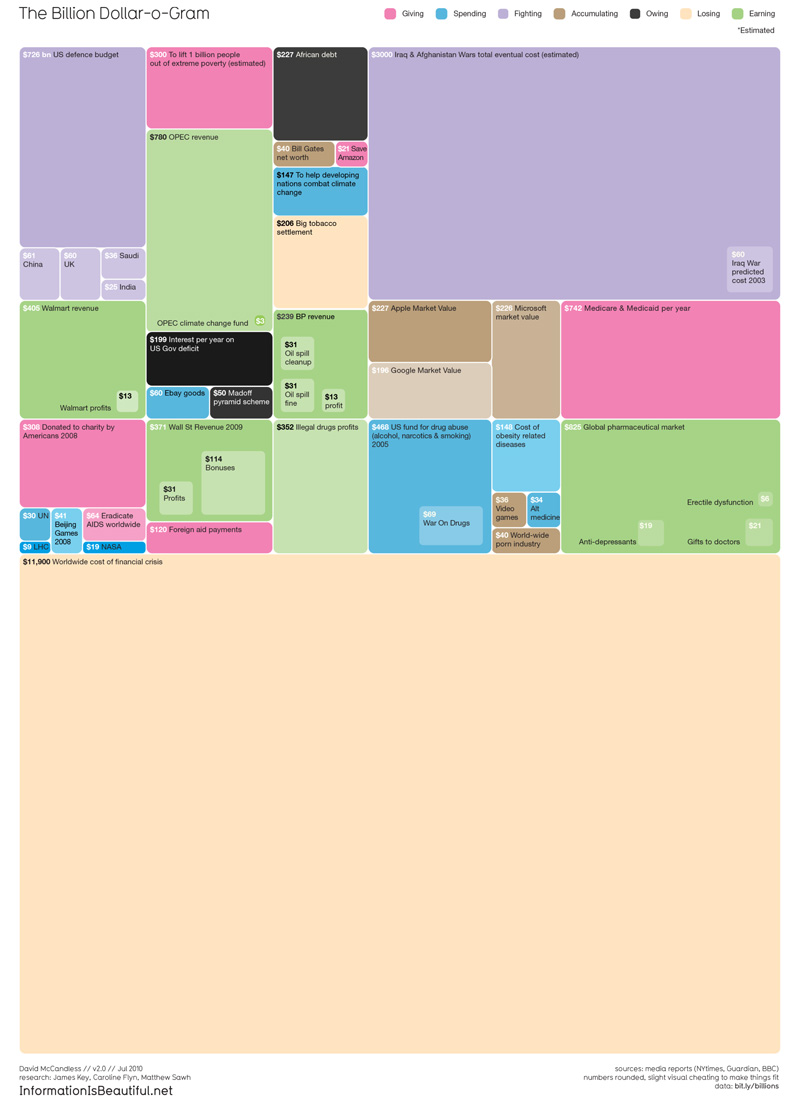Difference between revisions of "Holotopia: Power structure"
m |
m |
||
| Line 34: | Line 34: | ||
<p>A quick look at David McCandless' Billion-Dollar-o-Gram 2009 will show that the costs of two issues ("Worldwide cost of financial crisis" and "Iraq & Afganistan wars total eventual cost") dominate the image so dramatically, that the costs of issues ("to lift one billion people out of extreme poverty", "African debt", "save the amazon"...) seem insignificant in comparison.</p> | <p>A quick look at David McCandless' Billion-Dollar-o-Gram 2009 will show that the costs of two issues ("Worldwide cost of financial crisis" and "Iraq & Afganistan wars total eventual cost") dominate the image so dramatically, that the costs of issues ("to lift one billion people out of extreme poverty", "African debt", "save the amazon"...) seem insignificant in comparison.</p> | ||
| − | <h3> | + | <h3>The largest costs are <em>systemically</em> caused</h3> |
<p>We tell the story of Charles Ferguson's two award-winning documentaries to highlight—as he did in his films—that those two issues were systemically caused. Or in other words that they were "inside jobs", as the title of Ferguson's second film suggested. </p> | <p>We tell the story of Charles Ferguson's two award-winning documentaries to highlight—as he did in his films—that those two issues were systemically caused. Or in other words that they were "inside jobs", as the title of Ferguson's second film suggested. </p> | ||
Revision as of 13:27, 24 June 2020
Contents
H O L O T O P I A: F I V E I N S I G H T S
Power structure
Powered by ingenuity of innovation, the Industrial Revolution revolutionized the efficiency of human work. Where could the next revolution of this kind be coming from?
We look at the systems in which we live and work. Imagine them as gigantic machines, comprising people and technology. Their function is to take people's daily work as input, and turn it into socially useful effects. If our work has become incomparably more efficient and yet we've remained busy—should we not see whether they might be wasting our time? And if our best efforts result in problems rather than solutions—should we not check whether they might be causing those problems?
Stories
Power structure wastes resources
A costly oversight
While the ingenuity of our innovation has been focused on small gadgets we can hold in our hand—those 'gigantic machines' constitute a proportionally more important, and yet overlooked creative frontier. How much is this oversight costing us?
On Page 4 of the article The Game-Changing Game–A Practical Way to Craft the Future we answered this question by giving a summary of our Ferguson–McCandless–Fuller thread, of which we here highlight the main points.
As always, our stories are intended to illustrate rather than rigorously prove the proposed views.

David McCandless: The Billion-Dollar-o-Gram 2009
A quick look at David McCandless' Billion-Dollar-o-Gram 2009 will show that the costs of two issues ("Worldwide cost of financial crisis" and "Iraq & Afganistan wars total eventual cost") dominate the image so dramatically, that the costs of issues ("to lift one billion people out of extreme poverty", "African debt", "save the amazon"...) seem insignificant in comparison.
The largest costs are systemically caused
We tell the story of Charles Ferguson's two award-winning documentaries to highlight—as he did in his films—that those two issues were systemically caused. Or in other words that they were "inside jobs", as the title of Ferguson's second film suggested.
Fuller may have been right
In the late 1960s, Buckminster Fuller predicted that by the end of the century science and technology would have advanced enough to enable us, the people on the planet, to put an end to scarcity. And that our core challenge would be to reconfigure the use and distribution of those resources—which now sapped through scarcity-based competition.
What we have just seen suggests that Fuller may have been right.
In 1969 Fuller proposed to the American Senate a computer-based solution called the World Game. Its whose purpose was to enable the global policy makers to see the world as one, and collaborate on allocating and sharing its resources, instead of competing.

